
Goats Like Argan. We do Too
A lot of our products use argan oil. This includes our Body Serum, Hand and Body Wash and Eye Illuminating Serum among many others. We thought we'd take a moment and tell you more about this wonderful, healthful oil.
In the semi-arid southwest of Morocco grows Argania. This is a gnarly, thorny tree. It grows about 30-35 feet tall, lives for 200 years and when the Berber women in the region harvest the small fruit that grows on it, they begin the labor intensive process that produces the argan oil they've used for centuries and we in the West have caught on to in the last thirty years or so.
The argan story is a fascinating one. It includes women's economic empowerment; local, regional and global conservation efforts; cultural and agricultural clashes; and soaring prices that make argan the most expensive oil in the world.
But let's start with goats.
If you're lucky enough to visit the region, you'll find goats in the argan trees. They're up there eating leaves and the small, pulpy argan fruit that comes out in early summer.
Locals take advantage of this. Goats may eat the fruit, but they don't digest the hard argan nut inside. Instead, they either spit or poop it out where it can be more easily gathered off the ground for processing. Otherwise, locals wait until the fruit falls from the trees in July.
The processing itself is typically done by the women using traditional, if labor intensive, techniques. They remove the pulp from the fruit and then crack the nut between two stones. The seeds are removed, gently roasted and ground to a paste. The paste is then squeezed by hand to extract the oil.
Global interest in argan oil for food and cosmetics has created a gold rush with the undeniable benefits to the rural communities that produce it.
Notably, women's collectives exist now to produce argan at scale for a world market. In addition to providing economic independence to the producers, the collectives also introduced literacy and women's health initiatives.
On the flip side, with prosperity comes unintended consequences that harm the trees. Namely, more goats.
Look at it this way, if goats help locals harvest the fruit, it makes sense that they've gotten more goats to harvest more fruit. It does, after all, take over 200 pounds of fruit to make liter of oil. Unfortunately, goats aren't delicate, do real damage to the trees and threaten the very resource that benefits the livelihoods of so many.
Enter UNESCO and the Moroccan government
In 1998, UNESCO designated the argan forest in southwestern Morocco a biosphere reserve. The economic importance of providing global recognition is obvious with argan oil's price per liter approaching $300 on the international market.
Environmental considerations are even more important. Besides sustaining local wildlife and agriculture, researchers believe the argan tree is essential to preventing desertification from an ever encroaching Sahara. Morocco is mostly desert and the Sahara borders its eastern and southern borders. The argan biosphere creates a buffer zone between usable agricultural land and lifeless desert sands.
The Moroccan government is trying to expand the area in which argania grows. To do so, they're creating new preserves, cultivating new trees and prohibiting fruit harvesting from these areas. The success of these efforts is mixed. Basically, the issue is one that's familiar anywhere a lucrative natural resource is withheld from locals who once managed it communally:
"The total bans on argan exploitation in designated “core” and “buffer” zones may be too rigid to promote both ecological and economic resilience... Natural trees do not produce as much fruit as trees pruned by experienced human hands, but the state’s controls on the core zones make it harder for [local] people to care for those trees and make it illegal to collect whatever harvest the trees do produce."
Such then is the tension between preservation, conservation and the economic potential flowing through the region.
Important though is the local, national and global partnership that is working on these issues. The effort to promote argan oil while protecting the argania is less than 25 years old. In that time, a billion dollar global market emerged out of a resource that few outside the region knew anything about.
With efforts to ensure that the rural communities that create argan oil continue to benefit, the next 25 years could very well see a sustainable model to the cultivation of a delicate ecosystem.
Follow the goats and keep an eye on southwestern Morocco.


Comments
Stephanie Additon said:
Tree goats are AMAZING…love the information about Argan Oil and why it is so special. JAVA products are, as you know, my favorite.
May 30, 2022